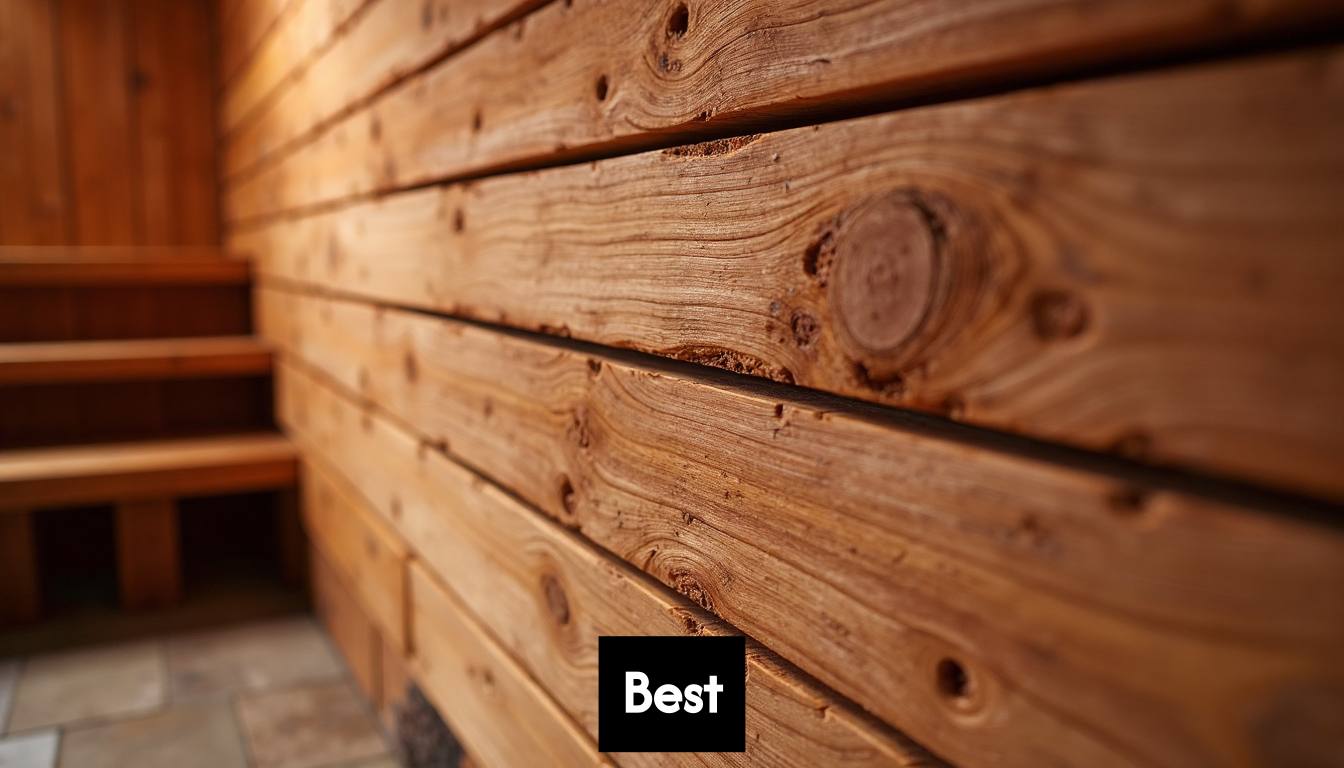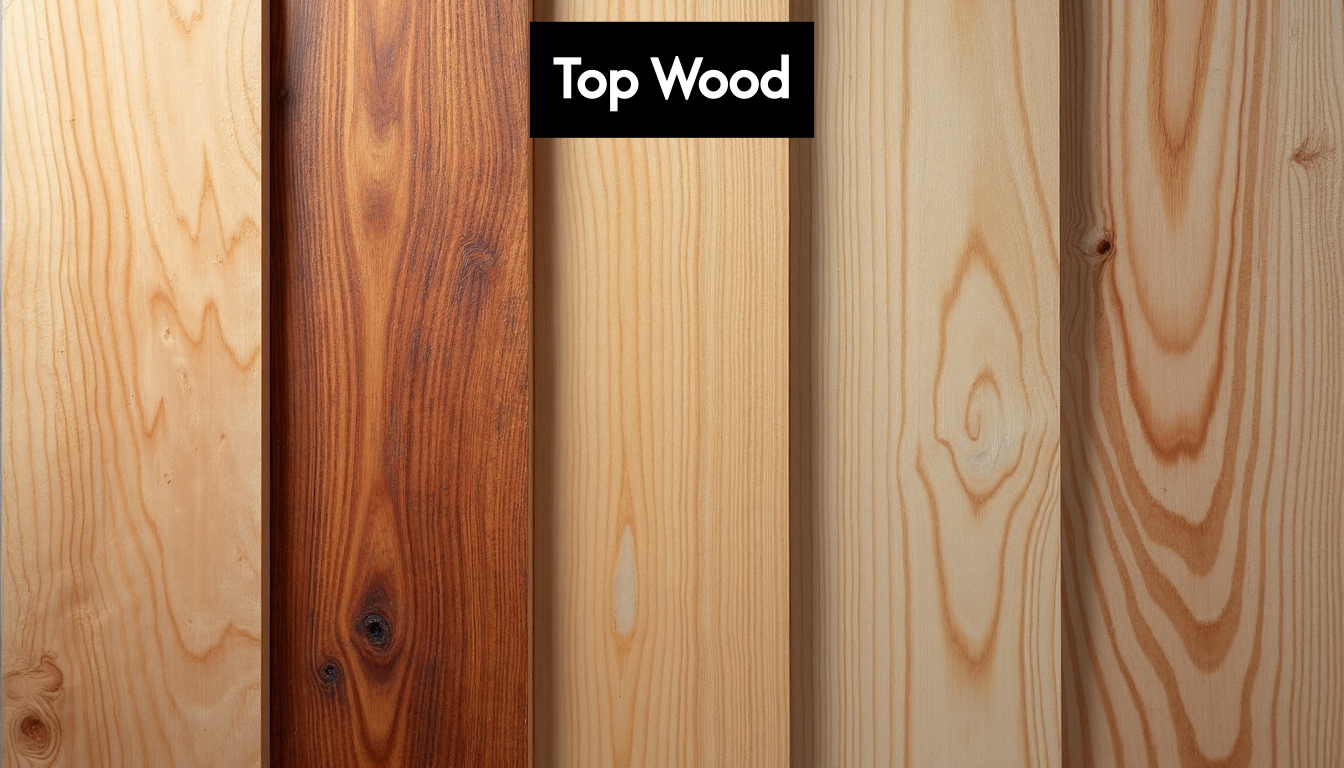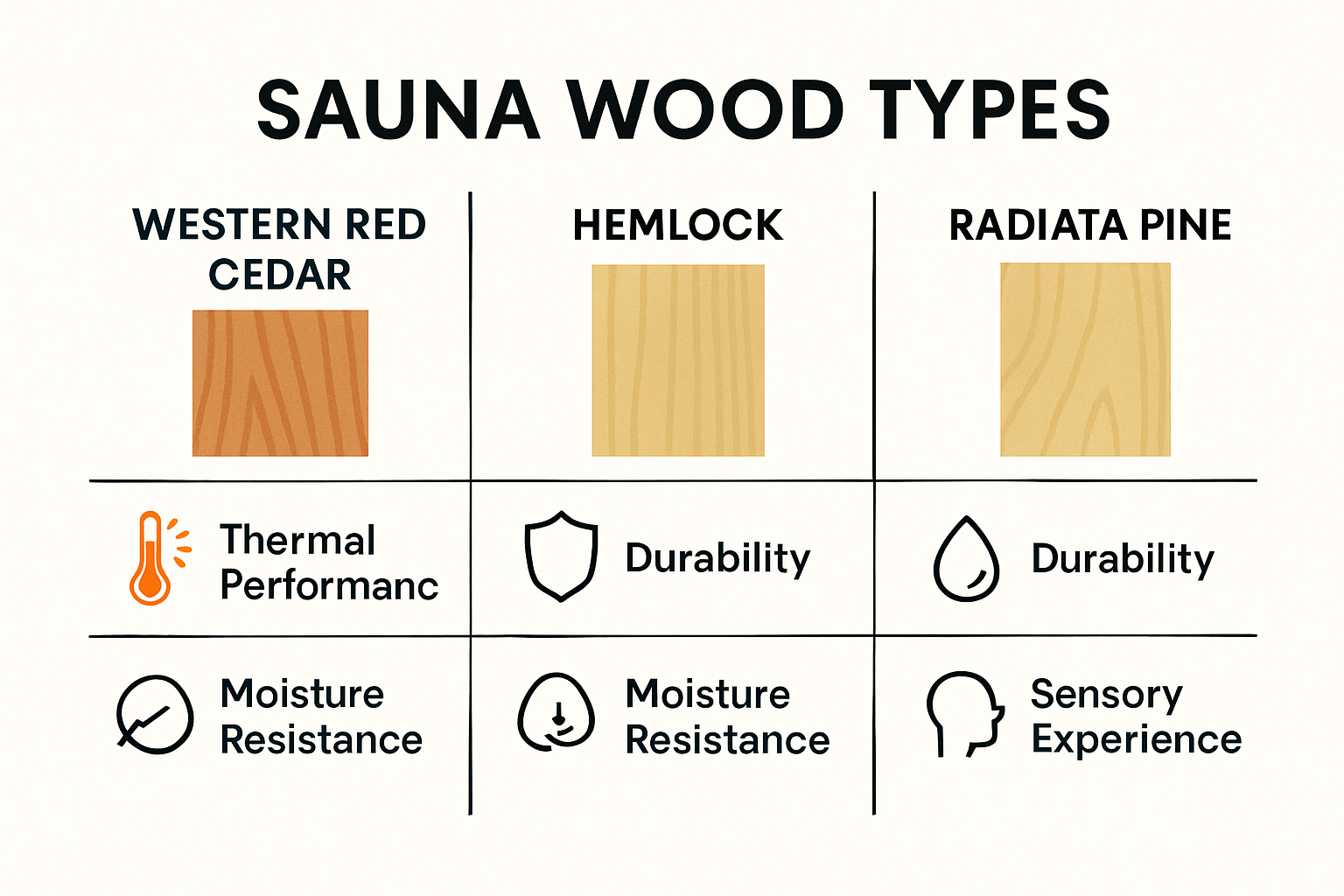
Choosing the Best Sauna Materials for 2025
 Choosing sauna materials for 2025 is about more than picking wood that looks good. Here is something surprising. Cedar can cost up to twelve dollars per square foot and people still line up for it. That is because what makes or breaks your sauna is not the price or popularity of the wood at all. The real story lies in the way heat, durability, and even aroma can turn your steam into a full sensory wellness sanctuary.
Choosing sauna materials for 2025 is about more than picking wood that looks good. Here is something surprising. Cedar can cost up to twelve dollars per square foot and people still line up for it. That is because what makes or breaks your sauna is not the price or popularity of the wood at all. The real story lies in the way heat, durability, and even aroma can turn your steam into a full sensory wellness sanctuary.
Table of Contents
- Choosing The Best Sauna Materials For 2025
- Why Material Choice Matters For Saunas
- Top Wood Types For Sauna Construction
- Considering Non-Wood Sauna Materials
- Maintaining Your Chosen Sauna Materials
Quick Summary
| Takeaway | Explanation |
|---|---|
| Material choice affects sauna performance | The right materials enhance thermal efficiency, moisture resistance, and sensory experience, transforming a sauna into a premium wellness sanctuary. |
| Opt for high-quality woods | Western Red Cedar and Hemlock are recommended for their thermal properties and durability, while Radiata Pine offers modern benefits without common wood issues. |
| Explore non-wood materials | Consider using tempered glass for durability and aesthetics, and ceramic or stone for natural heat retention, which can enhance sauna design and functionality. |
| Regular maintenance is essential | Implement gentle cleaning practices and seasonal care to preserve the integrity of sauna materials and ensure a hygienic environment. |
| Avoid harmful chemical treatments | Use only heat-resistant, non-toxic products on wood surfaces to maintain their natural properties and prevent health risks. |
Why Material Choice Matters for Saunas
Choosing the right materials for your sauna is far more than a simple aesthetic decision. The materials you select directly impact your sauna’s performance, durability, health benefits, and overall user experience. Understanding the critical role of materials can transform your sauna from a basic heat chamber into a premium wellness sanctuary.
Thermal Performance and Heat Retention
The primary function of any sauna is to generate and maintain consistent heat. Best sauna materials play a crucial role in this process. Wood species like cedar and hemlock are exceptional choices because of their unique thermal properties. According to Alpha Sauna research, these woods have low thermal conductivity, which means they efficiently retain heat while preventing rapid temperature fluctuations.
This thermal stability ensures a more comfortable and consistent sauna experience. Imagine stepping into a sauna where the heat distributes evenly, creating a uniform warmth that penetrates your muscles and promotes relaxation. Materials with poor heat retention would create uncomfortable cold spots and require more energy to maintain temperature.
Moisture Resistance and Durability
Saunas are high-humidity environments that constantly challenge material integrity. The best sauna materials must withstand extreme temperature changes, high moisture levels, and potential bacterial growth. Experts at Sun Valley Saunas recommend thermally modified woods like aspen and Alaskan yellow cedar for their exceptional moisture resistance and dimensional stability.
These specialized woods prevent common issues such as warping, mold growth, and structural degradation. Cedar, in particular, stands out with its natural antimicrobial properties and pleasant aroma. Home Depth research indicates that quality cedar can cost between $8–12 per square foot, representing a worthwhile investment in long-term sauna performance and hygiene.
Health and Sensory Experience
Beyond technical performance, material choice significantly influences your sauna’s health benefits and sensory experience. Natural woods like cedar release subtle, therapeutic aromas when heated. These aromatic compounds can have mild stress-reducing and mood-enhancing effects. Moreover, non-toxic, hypoallergenic materials prevent potential skin irritations or respiratory issues during prolonged heat exposure.
The texture and feel of the materials also matter. Smooth, carefully selected woods provide a comfortable surface that feels pleasant against the skin, enhancing the overall relaxation experience. Cheaper or synthetic materials might feel harsh, cold, or emit unpleasant odors when heated, dramatically reducing your sauna’s therapeutic potential.
Selecting the right sauna materials is an investment in your wellness journey. By prioritizing thermal efficiency, moisture resistance, and sensory quality, you create a personal sanctuary that supports physical recovery, mental relaxation, and holistic health.
Top Wood Types for Sauna Construction
 Selecting the right wood for sauna construction is a critical decision that impacts performance, durability, and overall user experience. Not all woods are created equal when it comes to withstanding high temperatures, moisture, and repeated thermal cycling. Understanding the unique characteristics of different wood types can help you make an informed choice for your best sauna materials.
Selecting the right wood for sauna construction is a critical decision that impacts performance, durability, and overall user experience. Not all woods are created equal when it comes to withstanding high temperatures, moisture, and repeated thermal cycling. Understanding the unique characteristics of different wood types can help you make an informed choice for your best sauna materials.
Western Red Cedar: The Premium Choice
Sun Valley Saunas consistently highlights Western Red Cedar as the gold standard for sauna construction. This wood offers an exceptional combination of properties that make it ideal for high-temperature environments. Its natural resistance to decay and insects provides long-lasting durability, while its excellent insulation properties ensure consistent heat distribution.
Western Red Cedar brings more than just functional benefits. The wood emits a distinctive, pleasant aroma that enhances the sensory experience of sauna use. Its low density allows it to remain cool to the touch, even in high-heat conditions, making it comfortable for sauna benches and interior surfaces. The wood’s natural oils also contribute to its resistance to moisture and bacterial growth, creating a hygienic sauna environment.
Hemlock: The Reliable Performer
Leisure Equip experts recommend hemlock as another top-tier option for sauna construction. This wood stands out for its remarkable stability and uniform texture. Hemlock demonstrates an impressively low rate of expansion and contraction, which is crucial in the extreme temperature fluctuations of a sauna environment.
The wood’s consistent grain and light color create a clean, modern aesthetic that appeals to many sauna enthusiasts. Hemlock benches and walls provide a smooth, splinter-free surface that remains comfortable and visually appealing over time. Its natural thermal properties help maintain even heat distribution, contributing to a more enjoyable sauna experience.
Radiata Pine: The Innovative Alternative
 Fluidra’s commercial solutions highlight Radiata pine as an innovative wood choice for sauna construction. What sets this wood apart is its unique characteristics when thermally modified. Unlike some woods that secrete resin or create uncomfortable surfaces, Radiata pine offers a luxurious finish without common wood-related issues.
Fluidra’s commercial solutions highlight Radiata pine as an innovative wood choice for sauna construction. What sets this wood apart is its unique characteristics when thermally modified. Unlike some woods that secrete resin or create uncomfortable surfaces, Radiata pine offers a luxurious finish without common wood-related issues.
Thermal modification transforms the pine, making it incredibly stable and resistant to moisture. The process eliminates exposed knots and reduces the wood’s tendency to splinter or overheat. This makes Radiata pine an excellent option for those seeking a more modern, low-maintenance sauna material. Its lighter weight and ability to withstand high temperatures make it particularly attractive for custom sauna designs.
Choosing the right wood is more than a technical decision it’s about creating a personal wellness sanctuary. Whether you prefer the classic aroma of Western Red Cedar, the reliable performance of Hemlock, or the innovative properties of Radiata pine, each wood type offers unique benefits that can elevate your sauna experience. Consider your specific needs, aesthetic preferences, and budget when selecting the perfect wood for your sauna construction.
Considering Non-Wood Sauna Materials
While wood has traditionally dominated sauna construction, emerging technologies and innovative materials are expanding the possibilities for best sauna materials. Non-wood alternatives offer unique advantages that can address specific design requirements, performance needs, and aesthetic preferences. Understanding these materials can help you make a more informed decision about your sauna construction.
Tempered Glass: Modern Transparency and Durability
Alpha Sauna research highlights tempered glass as a revolutionary non-wood material for sauna construction. Unlike traditional wooden surfaces, tempered glass provides exceptional non-porous characteristics that resist moisture absorption and prevent bacterial growth. Its smooth surface creates a sleek, contemporary aesthetic that transforms the visual experience of a sauna.
Tempered glass offers remarkable durability and structural integrity. Engineered through a specialized heating and cooling process, this material is significantly stronger than standard glass. It can withstand dramatic temperature variations without compromising its structural composition. For sauna doors and panels, tempered glass introduces an element of visual openness while maintaining robust thermal performance.
Ceramic and Stone Materials: Natural Heat Retention
Ceramic and stone materials represent another fascinating alternative in non-wood sauna construction. These natural materials possess extraordinary thermal mass properties, meaning they absorb and radiate heat exceptionally well. Ceramic tiles and stone surfaces can create a unique sensory experience, offering a different approach to heat distribution compared to traditional wooden interiors.
Stone surfaces like granite or volcanic rock have been used in traditional steam rooms and saunas for centuries. Their dense molecular structure allows them to store heat efficiently, creating a more consistent temperature environment. Modern ceramic technologies have further enhanced these materials’ performance, developing tiles and panels specifically designed for high-temperature applications.
Hybrid Design: Combining Materials for Optimal Performance
Alpha Sauna experts recommend exploring hybrid sauna designs that strategically combine different materials. By integrating non-wood elements like tempered glass with traditional wooden frames, you can create a sauna that maximizes both aesthetic appeal and functional performance.
Hibrid designs offer several compelling advantages. Glass panels can provide visual lightness and a sense of spaciousness, while wooden frames maintain the traditional warmth and natural feel. This approach also addresses potential material limitations. For instance, combining glass with wood can reduce warping issues and enhance overall structural longevity.
Choosing non-wood sauna materials is not about replacing traditional approaches but expanding your design possibilities. Each material brings unique properties that can enhance your sauna experience. Whether you prioritize modern aesthetics, superior heat retention, or innovative design flexibility, non-wood materials offer exciting alternatives to conventional wooden construction.
Maintaining Your Chosen Sauna Materials
Proper maintenance of sauna materials is crucial for preserving their performance, appearance, and longevity. Regardless of whether you’ve chosen wood, glass, or hybrid materials, each best sauna materials selection requires specific care strategies to ensure optimal functionality and hygiene.
Cleaning and Regular Maintenance
Everything Billiards experts emphasize the importance of consistent, gentle cleaning for sauna surfaces. Unlike standard home surfaces, sauna materials require specialized maintenance that preserves their natural properties. For wooden interiors, avoid harsh chemical cleaners that can damage the wood’s natural protective qualities.
Use a soft, dry cloth or mild water-based solution to wipe down surfaces after each use. Remove excess moisture to prevent potential bacterial growth or wood degradation. Pay special attention to benches and high-contact areas, ensuring they remain clean and free from sweat residue. A mixture of water and mild soap can be used sparingly, followed by thorough drying to maintain the wood’s integrity.
Protecting Wood Surfaces
Almost Heaven Sauna guides strongly recommend against using chemical sealants or artificial finishes on interior sauna wood. High temperatures can cause these treatments to off-gas harmful chemicals, compromising both the wood’s natural properties and user health. The key is to maintain the wood’s natural ability to absorb and release heat and moisture.
For specific areas like door handles and floorboards that experience more direct contact and potential dirt accumulation, a light wood sealant or polyurethane finish might be acceptable. However, these should be applied sparingly and with heat-resistant, non-toxic products. Periodic light sanding can help refresh wooden surfaces, removing any minor surface imperfections and maintaining a smooth, splinter-free finish.
Seasonal and Long-Term Care
Seasonal maintenance is critical for preserving your sauna’s materials. During periods of low use, ensure proper ventilation to prevent moisture buildup. Leave the sauna door slightly open after use to allow complete drying and prevent potential mold or mildew growth. For glass or hybrid materials, use a specialized glass cleaner that doesn’t leave residue and maintains the material’s clarity and shine.
Check wooden surfaces annually for signs of wear, checking for loose boards, potential warping, or areas that might need minor repair. Small maintenance tasks performed regularly can prevent more significant issues down the line. If you notice any structural changes or unusual surface conditions, address them promptly to maintain the sauna’s performance and safety.
Maintaining your sauna is an investment in your wellness experience. By understanding the specific care requirements of your chosen materials, you can ensure a clean, safe, and enjoyable sauna environment for years to come. Remember that each material has its unique characteristics, and a tailored maintenance approach will help preserve its natural beauty and functional integrity.Consider your specific wellness goals, spatial constraints, and personal preferences when exploring these innovative sauna material options.
Frequently Asked Questions
What wood is best for sauna construction in 2025?
Western Red Cedar, Hemlock, and Radiata Pine are excellent choices for sauna construction due to their thermal properties, durability, and moisture resistance. Each wood type brings unique benefits to enhance your sauna experience.
How do the materials affect sauna performance?
The materials chosen for a sauna significantly impact thermal efficiency, moisture resistance, and overall user experience. High-quality woods or innovative non-wood materials contribute to a more consistent and enjoyable sauna experience.
Are there non-wood materials suitable for saunas?
Yes, non-wood materials like tempered glass, ceramic, and stone can be excellent alternatives for sauna construction. They offer unique advantages such as durability, aesthetics, and exceptional heat retention.
What should I consider when maintaining sauna materials?
Proper maintenance of sauna materials includes regular cleaning with gentle solutions, protecting wood surfaces from harsh chemicals, and ensuring proper ventilation to prevent moisture buildup. These practices help preserve the sauna’s performance and hygiene.
Elevate Your Wellness Experience with the Right Sauna Materials
Choosing the best materials for your sauna is not just a detail; it’s the foundation of your wellness journey. As discussed in our recent article, the right wood types and innovative non-wood materials can dramatically enhance your sauna experience, ensuring optimal heat retention, moisture resistance, and sensory pleasure. Imagine stepping into a perfectly crafted sauna that not only looks stunning but feels like a true sanctuary for your mind and body.

At Best Life Sauna, we understand that your wellness deserves nothing but the best. Offering a curated selection of saunas, including infrared and traditional options, we also provide the ideal sauna accessories that align with your unique needs. Whether you’re seeking the calming aroma of premium Western Red Cedar or the modern elegance of tempered glass, we have the perfect solutions for you. Plus, enjoy free shipping on orders over $200 and the peace of mind that comes with our price match guarantee.
Don’t wait to transform your relaxation space into a premium wellness sanctuary! Visit Best Life Sauna today and discover how our top-notch products can help you achieve your health goals NOW!
Recommended Articles
- Sauna for Respiratory Health: Benefits & Tips 2025 – Best Life Sauna
- Embrace Wellness: Paying for Your Sauna with FLEX at Best Life Sauna Best Life Sauna - Premium Saunas for WellnessAmerican ExpressApple PayDiners ClubDiscoverGoogle PayMastercardPayPalShop PayVisa
- Sauna Routine to Promote Deep Sleep – Best Life SaunaBest Life Sauna - Premium Saunas for WellnessAmerican ExpressApple PayDiners ClubDiscoverGoogle PayMastercardPayPalShop PayVisa
- Discover the Benefits of Outdoor Saunas for Health, Relaxation & Home – Best Life SaunaBest Life Sauna - Premium Saunas for WellnessAmerican ExpressApple PayDiners ClubDiscoverGoogle PayMastercardPayPalShop PayVisa
- Discover the Best Time to Use Sauna for Optimal Health – Best Life Sauna

